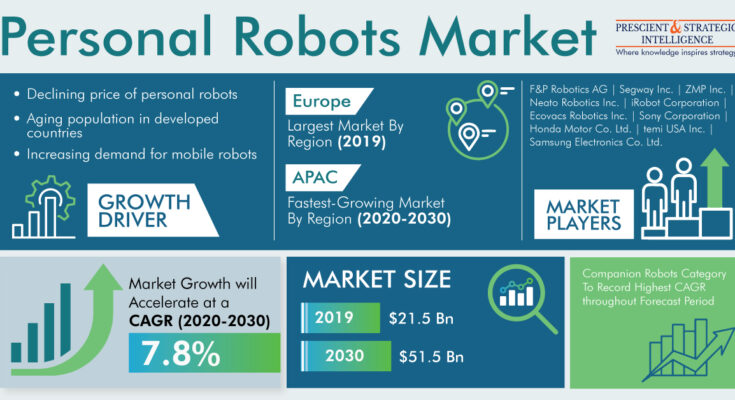One of the major factors fueling the demand for personal robots is their falling prices across the world. According to industry experts, the prices of personal robots are plunging by 2–9% every year. This is consequently augmenting the sale of these robots both in the developing and developed nations. Moreover, the production of these robots is predicted to shift to various lower-cost regions in the coming years, on account of their mushrooming demand in the developing countries.
This will make them more affordable in the years to come. For instance, iRobot Corporation announced in November 2019 that it has started robot manufacturing at its factor located in Malaysia ahead of schedule. The other important factor propelling the sales of personal robots is ballooning popularity of mobile robots, primarily because of escalating security concerns. These robots are integrated with automation and artificial intelligence (AI) technologies and can thus, move from one place to another on their own.
Get More Insights: Personal Robots Market Revenue Estimation and Growth Forecast Report
As a result, they are used for spying and are, therefore, also called spying robots. They can detect unidentified persons and make noises to alert the house owner about intrusion or other suspicious activities. Furthermore, the integration of the internet of things (IoT) has made these robots more mobile, thereby causing a massive rise in the size of the area that they can cover and keep secure. Because of these reasons, the popularity of these robots is growing rapidly.
Besides the aforementioned factors, the surging geriatric population, especially in the developed countries, is also positively impacting the demand for personal robots across the world. This is, in turn, driving the expansion of the global personal robots market. As a result, the market revenue is expected to grow from $21.5 billion in 2019 to $51.5 billion by 2030. Furthermore, the market is predicted to advance at a CAGR of 7.8% from 2020 to 2030.
When offering is taken into consideration, the market is bifurcated into software and hardware. Between these, the software category is predicted to exhibit the faster growth in the personal robots market in the upcoming years. This is because software is a critical component of personal robots as it helps these robots move and operate as efficiently and effectively as possible by incorporating latest updates and providing various advanced features to them.
For example, in the i series robots developed by iRobot Corporation, the visual simultaneous localization and mapping (vSLAM) technology utilizes an optical sensor so that the robot can create a highly-detailed map of its surroundings, which will help it understand its location and the places where cleaning is required. Geographically, the personal robots market will demonstrate the fastest growth in the Asia-Pacific (APAC) region in the forthcoming years, as per the estimates of the market research company, P&S Intelligence.
Hence, it can be said with surety that the demand for personal robots will rise sharply in the near future, primarily because of their rapidly falling prices and the growing popularity of mobile robots around the world.




